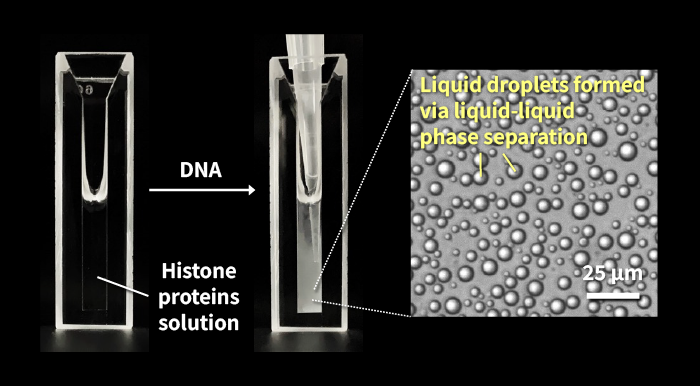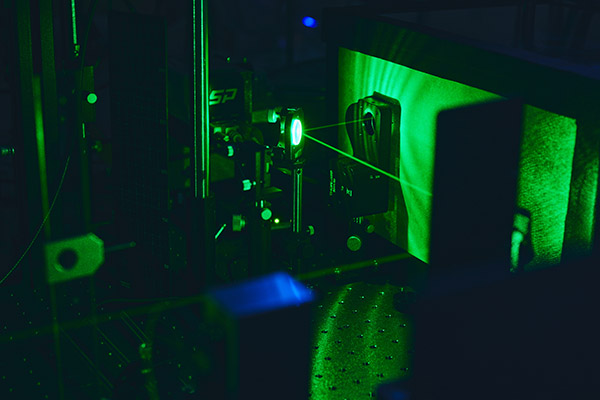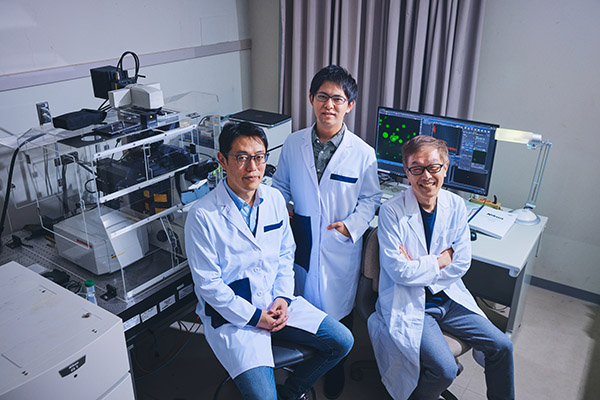Key Points
How do biomolecules such as DNA and proteins behave inside cells? The three-dimensional structure of DNA plays an important role in a phenomenon called “liquid-liquid phase separation”, in which a protein-rich phase separates within cells like oil and water. This phenomenon is deeply related to neurodegenerative diseases such as dementia and motor disorders. By elucidating it, the research aims to connect to drug discovery through industry collaboration. We interviewed Tomita Shunsuke, Chief Senior Researcher of the Nano-biodevice Research Group, Health and Medical Research Institute, who received the AIST Paper Award for this research.
What makes this research amazing?Discovery of a new function of DNA structures related to the onset of intractable diseases!
Development of manipulation and measurement techniques for liquid-liquid phase separation research and dissemination of the technology throughthe publication of explanatory articles.
What inspired you to start this research?
TomitaMy former mentor, Professor Shiraki Kentaro of the University of Tsukuba, who is a leading figure in Japan's "liquid-liquid phase separation" research, posted on social media in 2017, saying, "Liquid-liquid phase separation is fascinating right now." This caught my interest in the topic.
Later, I came to understand that the liquid-liquid phase separation is one of the mechanisms that allow proteins and other biomolecules to gather in the correct locations to support cellular functions. Coming from a background in physical chemistry, I have always been interested in understanding the functions of biomolecules like proteins based on their behavior, so I quickly began my research on this topic.
What aspects did you focus on as you progressed with the research?
TomitaIt had been previously known that mixing nucleic acids such as RNA and DNA with certain proteins could induce liquid-liquid phase separation. However, the specific role of DNA in this process was not well understood.
Through discussions with Mimura Masahiro, the first author of this paper and a graduate student at the University of Tsukuba at the time, we came up with the idea of focusing on the three-dimensional structure of DNA. In particular, we paid attention to the guanine quadruplex. The DNA guanine quadruplex is a three-dimensional structure that is involved in the regulation of gene expression.
We hypothesized that mixing a guanine quadruplex DNA with histone proteins, which help bundle DNA into chromosomal structures, could induce liquid-liquid phase separation. If we could confirm this phenomenon, we thought we might be able to propose a new “mechanism” for controlling the chromosome structure that binds DNA.
 Liquid-liquid phase separation forms spherical droplets in aqueous solutions
Liquid-liquid phase separation forms spherical droplets in aqueous solutions
What challenges did you encounter while writing the paper?
TomitaThis paper was published in the Journal of the American Chemical Society (JACS), which is highly regarded in the field of chemistry. However, it was initially rejected due to insufficient experimental evidence. At that point, we had the option of submitting it to another journal, but we chose not to give up and decided to resubmit it.
Since this was my first paper on liquid-liquid phase separation, which was a new research topic for me, I wanted to publish it in a high-impact journal to reach as many people as possible. The reviewers raised critical questions, such as “Is the DNA really forming quadruplex structures inside the liquid droplets formed via liquid-liquid phase separation?” In response, we spent about a year conducting additional experiments, and eventually, we were able to get it accepted.
Were the experiments carried out smoothly?
TomitaNot at all. One of the major challenges was handling the liquid droplets used for observation and measurement. These liquid droplets contain high concentrations of proteins and DNA, making them highly viscous and sticky. Moreover, they exist in extremely small amounts, which made extracting them quite difficult. We struggled to find a way to measure the internal state of these minute samples, but with the help of researchers from other fields at AIST, we found a solution.
Hosokai Takuya from the Research Institute for Material and Chemical Measurement introduced us to a technique for measuring the fluorescence lifetime of molecules. By sandwiching the liquid droplets, we had managed to extract between two pieces of glass and making them into a handmade measurement sample, we were able to measure the molecules that have the property of binding to the quadruplex structure of DNA even within the liquid droplets. Additionally, for experiments capturing molecular movements inside the liquid droplets, Shinkai Yoichi from the Biomedical Research Institute assisted us using fluorescence imaging technology. Thanks to their contributions, we successfully measured the internal state of the liquid droplets and confirmed that the DNA quadruplex structure forms inside them. We also clarified how this structure influences the properties of the droplets. Dr. Shinkai is researching the nematode, in which liquid-liquid phase separation was first discovered within cells, and neurodegenerative diseases, and we were able to have discussions that incorporated a biological perspective, which led to the creation of more reliable results. Conducting experiments from various perspectives was challenging, but after the paper was published, we received inquiries from pharmaceutical companies and even had the opportunity to contribute to textbooks. This reinforced my belief that we are making tangible progress in advancing this research field. In this way, I feel that one of the strengths of AIST is that we can easily collaborate with researchers from various fields.
 The fluorescence lifetime measurement device at AIST Nanocharacterization Facility (ANCF) measures the quadruplex structure inside the liquid droplet.
The fluorescence lifetime measurement device at AIST Nanocharacterization Facility (ANCF) measures the quadruplex structure inside the liquid droplet.
I want people like you to know about thisFrom basic research to analytical technology development and drug discovery applications in startup ventures
We will work to solve the issues of an aging society through an integrated research system.
Understanding the “liquid-liquid phase separation” phenomenon has revealed its connection to neurodegenerative diseases
TomitaRecent research advancements have increasingly demonstrated that liquid-liquid phase separation is closely involved in neurodegenerative diseases such as dementia and motor disorders. It is also suggested that the disruption of liquid-liquid phase separation regulation can trigger the abnormal accumulation of proteins. Understanding this phenomenon in detail is considered the “missing piece” to significantly advancing research on the prevention and treatment of neurodegenerative diseases, which are becoming more severe in our super-aging society.
To accelerate the social implementation of our research findings, we established Molmir Inc., an AIST-certified venture company, with a team of researchers who share the same aspirations. We aim to develop drugs for the prevention and treatment of intractable diseases caused by neurodegeneration, such as amyotrophic lateral sclerosis (ALS).
How do you plan to further develop your research?
TomitaIn our group, we are not only working on basic research such as the liquid-liquid phase separation we have been working on this time, but also on the development of analytical technology and its application to drug discovery.
For example, our group has developed an analytical technology called "Chemical tongue," which can analyze various biological samples and molecules by artificially imitating the mechanism of taste. We believe that this technology can be applied not only to biotechnology and the food industry, but also to drug discovery, and we are actually using it in research aimed at developing pharmaceuticals that target liquid-liquid phase separation.
From now on, we would like to continue to promote the further social implementation of our research results, while discussing and collaborating with people from various positions and fields, from the elucidation of basic phenomena to the development of original analytical technologies, and their application to drug discovery.
If you are interested in this research, please feel free to reach out to us.
 A laser confocal fluorescence microscope used to observe liquid droplets and three researchers in the field of biology. (From the left: Shinkai, Tomita, and Kurita, the group leader of Nano-biodevice Research Group to which Tomita belongs.)
A laser confocal fluorescence microscope used to observe liquid droplets and three researchers in the field of biology. (From the left: Shinkai, Tomita, and Kurita, the group leader of Nano-biodevice Research Group to which Tomita belongs.)